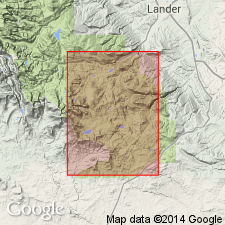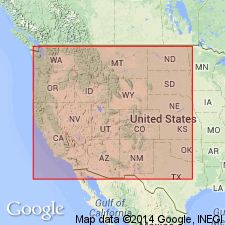
- Usage in publication:
-
- Louis Lake Granodiorite
- Modifications:
-
- Named
- Dominant lithology:
-
- Granodiorite
Summary:
Pg. 1136. Louis Lake Granodiorite. A batholith. Intrudes metamorphic sequence of graywacke, schist, greenstone, and iron-formation. Unconformably underlies Middle Cambrian and younger strata. Age is Precambrian X.
Type section: Louis Lake, south Wind River Mountains, Lat. 42 deg. 30 min. to 42 deg. 45 min. N., Long. 108 deg. 45 min. to 109 deg. 00 min. W., Fremont Co., west-central WY.
Source: US geologic names lexicon (USGS Bull. 1520, p. 186-187).

- Usage in publication:
-
- Louis Lake batholith*
- Modifications:
-
- Geochronologic dating
- AAPG geologic province:
-
- Wind River basin
Summary:
Pg. 30, geologic time scale (inside front cover). Louis Lake batholith. Sample from biotite-hornblende-quartz diorite in Louis Lake batholith, in sec. 14, T. 30 N., R. 101 W., [approx.] Lat. 42 deg. 34 min. N., Long. 108 deg. 52 min. W., Louis Lake quadrangle, Fremont County, Wyoming, yielded K-Ar ages of 2,630 +/-130 Ma (hornblende) and 2,210 +/-110 Ma (biotite), and Pb-alpha ages of 3,300 +/-370 Ma (zircon-2) and 3,000 +/-340 Ma (zircon-1). Bayley and others, 1973 (USGS Prof. Paper 793) reported K-Ar ages of 2,640 Ma (hornblende) and 2,210 Ma (biotite) for this sample; ages recalculated using decay constants of Steiger and Jager, 1977 (Earth Planet. Sci. Letters, v. 36, p. 359-362). Hornblende agrees with 2,600 Ma age reported by Naylor and others (1970). Biotite age too young; Pb-alpha ages too old. Sample from granite (mylonite) border facies of Louis Lake batholith in South Pass area, Wind River Range, in sec. 34, T. 30 N., R. 100 W., Lat. 42 deg. 31 min. 45 sec. N., Long. 108 deg. 46 min. 00 sec. W., Louis Lake quadrangle, Fremont County, Wyoming, yielded a K-Ar age of 1,430 +/-70 Ma (biotite). Published age 1,420 Ma (Bayley and others, 1973); recalculated using decay constants of Steiger and Jager (1977). Published Pb-alpha age of 1,240 Ma (zircon) by Bayley and others, (1973) is spurious. [Precambrian W and Precambrian Y]
Source: Publication.
For more information, please contact Nancy Stamm, Geologic Names Committee Secretary.
Asterisk (*) indicates published by U.S. Geological Survey authors.
"No current usage" (†) implies that a name has been abandoned or has fallen into disuse. Former usage and, if known, replacement name given in parentheses ( ).
Slash (/) indicates name conflicts with nomenclatural guidelines (CSN, 1933; ACSN, 1961, 1970; NACSN, 1983, 2005, 2021). May be explained within brackets ([ ]).

